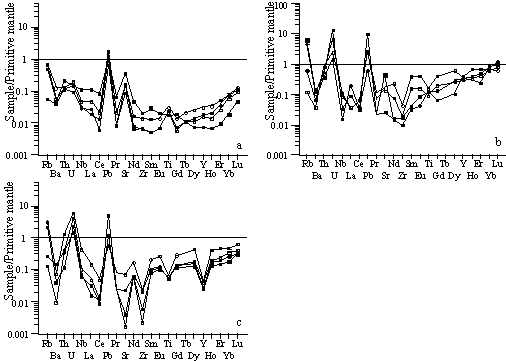
Mantle xenoliths from the Lihir Volcano Group (Papua New Guinea): evidence of a refractory mantle metasomatised by subduction-derived fluids
M. Grégoire, GEMOC, Macquarie, B.I.A. Mc Innes, CSIRO EM,
S.Y. O'Reilly, GEMOC, Macquarie
Numerous mantle xenoliths in addition to various volcanic, plutonic
and sedimentary xenoliths have recently been discovered in the
Tubaf volcano south of Lihir Island (New Ireland, Papua New Guinea).
The Tubaf submarine cinder cone (1280 m below sea level) is related
to the post-collisional high-K calc-alkaline volcanism (< 3.5
Ma) in the New Ireland fore-arc basin occuring after the collision
of the Ontong-Java plateau with the Australia-Pacific convergent
plate boundary.
Ultramafic xenoliths from Tubaf are spinel harzburgite (>90
%), with minor spinel lherzolite, which indicates that the Lihir
upper mantle is predominantly made up of refractory rocks. Many
peridotite xenoliths have been affected by a modal metasomatic
event evidenced by the occurrence of cross-cutting networks of
orthopyroxenite veins. The veins are dilational in nature with
no shear component and are inferred to have been produced by hydraulic
fracturing. They contain a metasomatic mineral assemblage consisting
of fibrous, radiating orthopyroxene and fine-grained Fe-Ni sulfide
with minor olivine, clinopyroxene, phlogopite and magnetite. No
silicate glass has been observed in the veins that are sharply
terminated at contacts with host volcanic rocks. The fibrous silicate
minerals are often euhedrally terminated and appear as if they
grew into open space from a fluid. Close to the veins the primary
peridotitic clinopyroxene and orthopyroxene becomes cloudy and
exhibit replacement textures characterized by a secondary fibrous
orthopyroxene similar to those occurring in the veins. This texture
is quite common in samples with no veins cross-cutting the peridotite,
inferring that the metasomatic agent transgressed through the
sample along grain boundaries as well as by hydraulic fracturing..
The mineralogical and geochemical characteristics of the Tubaf
mantle xenoliths are the product of at least two geological processes,
an early partial melting depletion event overprinted by a later
metasomatic enrichment event. Depletion by partial melting is
indicated by the high refractory indices of both whole rocks and
minerals (Fo87-91, Cr-rich spinel, high MgO and low CaO, Al2O3,
Na2O and total FeO contents in bulk-rock analyses). Modeling the
abundance of HREE in clinopyroxene from the least metasomatized
peridotites infers that they are the residues from a 15-25% partial
melting event (fractional melting model).
Trace element characteristics both in bulk rocks and minerals
suggest that the modal metasomatism event is responsible for the
chemical enrichment in the most incompatible trace elements of
the previously depleted mantle. The bulk rock REE content patterns
systematically display LREE enrichment over MREE (La/Sm: 5.8-8.5).
The trace element abundance patterns in both bulk rocks and minerals
(opx, cpx) show positive anomalies in Pb, U and sometimes Th and
Sr (Fig. 1).
The trace element characteristics, the presence of H2O-rich fluid
inclusions in the orthopyroxene and the lack of shear structures
in the veins indicates that the modal metasomatism event is recent
and probably occured via hydraulic fracturing may be caused by
the influx of slab-derived hydrous fluids into the upper mantle
beneath the Tubaf volcano. This oceanic upper mantle has been
previously affected by high degree of partial melting, probably
in an oceanic ridge context.

Back to the GEMOC Abstract Titles Page
© Copyright Macquarie University | Privacy Statement | Accessibility Information
Site Publisher: DVC Development and External Relations | Last Updated: 18 August 2008
ABN 90 952 801 237 | CRICOS Provider No 00002J